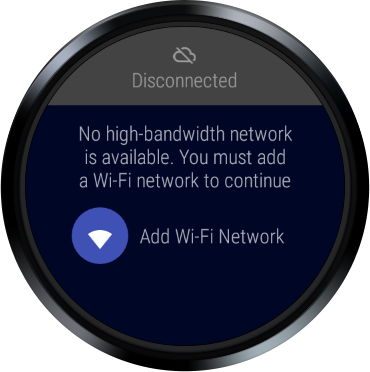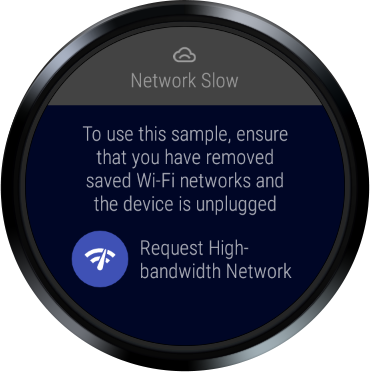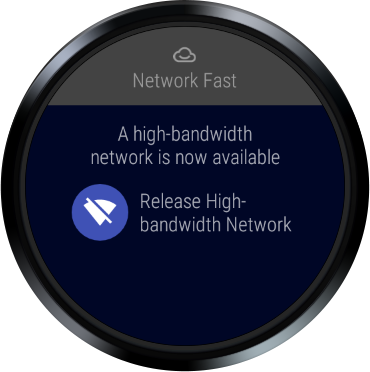Android WearHighBandwidthNetworking Sample
Sample demonstrates how to determine if a high-bandwidth network is available for use cases that require a minimum network bandwidth, such as streaming media or downloading large files. In addition, the sample demonstrates best practices for asking a user to add a new Wi-Fi network for high-bandwidth network operations if the bandwidth of currently available networks is inadequate.
Introduction
On Android Wear, a high-bandwidth network is not always available, as the platform manages network connectivity with the goal of providing the best overall user experience, balancing network bandwidth and maximizing device battery life. For use cases that require high-bandwidth network access, such as transporting large files or streaming media, we recommend that apps:
- Check for an active network, and if there is one, check its bandwidth.
- If there isn't an active network, or its bandwidth is insufficient, request access to an unmetered Wi-Fi or cellular network.
- If a high-bandwidth network is still not avaiable, ask the user to connect to a new Wi-Fi network.
You can use the ConnectivityManager class to check if an active network exists, if the active network has sufficient bandwidth for the desired network operation, and to request an appropriate high-bandwidth network.
In addition to requesting a high-bandwidth network, you should also ensure that you are releasing bound networks and cancelling any ongoing network requests when they are no longer needed.
This sample demonstrates all aspects of testing, requesting, and releasing network resources to ensure a high-bandwidth network is available. In addition, the sample demonstrates the ideal user experience for guiding the user through the process of acquiring a high-bandwidth network.
To try all aspects of this sample, ensure that you have removed all saved Wi-Fi networks from your Wear device and that it is unplugged, as Wear devices may prefer high-bandwidth networks by default while plugged-in. Also, you may wish to put your phone in airplane mode or turn off Bluetooth to simulate the Wear device running standalone.
Pre-requisites
- Android SDK 26
- Android Build Tools v26.0.1
- Android Support Repository
Screenshots



Getting Started
This sample uses the Gradle build system. To build this project, use the "gradlew build" command or use "Import Project" in Android Studio.
Support
- Google+ Community: https://plus.google.com/communities/105153134372062985968
- Stack Overflow: http://stackoverflow.com/questions/tagged/android
If you've found an error in this sample, please file an issue: https://github.com/googlesamples/android-WearHighBandwidthNetworking
Patches are encouraged, and may be submitted by forking this project and submitting a pull request through GitHub. Please see CONTRIBUTING.md for more details.
License
Copyright 2017 The Android Open Source Project, Inc.
Licensed to the Apache Software Foundation (ASF) under one or more contributor license agreements. See the NOTICE file distributed with this work for additional information regarding copyright ownership. The ASF licenses this file to you under the Apache License, Version 2.0 (the "License"); you may not use this file except in compliance with the License. You may obtain a copy of the License at
http://www.apache.org/licenses/LICENSE-2.0
Unless required by applicable law or agreed to in writing, software distributed under the License is distributed on an "AS IS" BASIS, WITHOUT WARRANTIES OR CONDITIONS OF ANY KIND, either express or implied. See the License for the specific language governing permissions and limitations under the License.
compile 'com.android.support:wear:26.0.0'
compile 'com.google.android.gms:play-services-wearable:11.4.0'
compile 'com.android.support:support-v13:26.1.0'
compile 'com.google.android.support:wearable:2.0.5'
compileSdkVersion 26
versionCode 1
versionName "1.0"
minSdkVersion 24
targetSdkVersion 26
package com.example.android.wearable.wear.wearhighbandwidthnetworking
versionCode 1
versionName 1.0
uses-permission
- android.permission.ACCESS_NETWORK_STATE
- android.permission.CHANGE_NETWORK_STATE
- android.permission.CHANGE_WIFI_STATE
- android.permission.INTERNET
MainActivity
This sample demonstrates how to determine if a high-bandwidth network is available for use cases that require a minimum network bandwidth, such as streaming media or downloading large files. In addition, the sample demonstrates best practices for asking a user to add a new Wi-Fi network for high-bandwidth network operations, if currently available networks are inadequate.
Click handler for the button in the UI. The view tag is used to determine the specific function of the button. * @param view The view that was clicked


